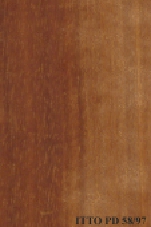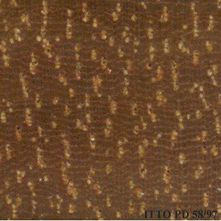
MAKORé (Tieghemella africana)
Trade Name
Makoré
Scientific Name
Tieghemella africana Pierre
Family
SAPOTACEAE
Common Names
Makoré (Côte d`Ivoire); Okolla (Gabon); Douka (Equatorial Guinea); Douka (Gabon); Okolla (Equatorial Guinea); Abacu (Ghana); Baku (Ghana); Ukola (Gabon)
Scientific Name Synonyms
Lecomtedoxa vazii Dubard; Dumoria africana (Pierre) Dubard; Baillonella africana (Pierre) Baehni
Description Of The Tree
Botanical Description
The tree reaches a height of more than 50 to more than 50 m. The bole is cylindrical, straight and clear to 32 m in length, unbuttressed. The trunk diameter attains 130 cm, sometimes even over 300 cm.A
Natural Habitat
Tieghemella africana is a timber species with a wide distribution in areas of lowland rainforest. It is found in dense virgin rain forests, often in large concentrations. It is known or inferred that unless the species is subject to strict regulation, i
Natural Distribution
West Africa, from Sierra Leone to Cameroon, Gabon and Cabinda.
Wood Identification
Anatomic Description Of Wood
Wood diffuse porous. Vessels in dendritic pattern. Vessels in diagonal and/or radial pattern. Occasionally vessels exclusively solitary (over 90%). Tangential diameter of vessel lumina 100 to 150 micras (small). Tyloses thin walled. Non-vestured pits. Vessels pe Axial parenchyma in continuous tangential lines or fine bands. Occasionally siliceous bodies in the axial parenchyma. 5 to 8 cells per parenchyma strand. Rays more than 10 per mm (abundant). Rays and/or axial elements irregularly storied. Rays non-storied. Rays 1 to 4 seriate. Silica bodies in the ray cells. Heterogeneous rays and/or multiseriate heterogeneous rays. Non-septate fibers. Fibers with simple to minutely bordered pits.
-
 Wood Macro Photo Tangential Plane
Wood Macro Photo Tangential Plane
-
 Wood Micro Photo Of Transversal Section
Wood Micro Photo Of Transversal Section
Availability
Cites Status
Unrestricted
General Wood Description
Color
The sapwood is whitish to pale pink, it has a thickness of 5 to 7 cm. The heartwood is from pinkish brown to dark red-brown, it is clearly demarcated. The silver figure is fine.
COLOR INDEX (1=Black, 7=Light yellow,white)
2
Grain
Straight or slightly interlocked, sometimes with an influence on further processing operations.
Texture
The texture varies from fine to medium.
Luster
The wood surface is described as low in luster.
Natural Durability
Very durable to decay; without preservative treatment. This species is especially suited for all the uses with risks of permanent or long-lasting humidification. Resistant to termites attack. Heartwood is resistant to Lyctus attacks.
Natural durability index (1= Very high durability, 7=Vey low durability)
1
Internal Growth Stresses
No growth stresses are reported in this species.
Silica Content
Silica Content: This timber is reported to have silica. Silica contents over 0.05% may affect wood processing. Silica Value: 0.3
Resistance To Impregnation
Difficult to treat with only a low penetration of the preservative products.
Wood Physical Properties
Basic Density or Specific Gravity (O.D. weight/vol. green) (g/cm³)
0.65
Air-dry Density (Weight and volume at 12%MC) (g/cm³)
0.72
Total shrinkage Tangential (Saturated to 0%MC) (%)
6.9
Total shrinkage Radial (Saturated to 0%MC) (%)
5.3
Drying Defects
Ease of Drying: Drying is fairly easy; some difficulties could occur when drying too fast. Drying Defects: Risks of distortions. Kiln Schedules: The kiln schedule has been tested.
Recommended Dry Kiln Schedule
FR-4
Dimensional stability ratio (Total Tangential Shrinkage %/Total Radial Shrinkage %)
1.3
Wood Chemical Properties
Wood Mechanical Properties
Bending Strength (MOR),12%MC (kgf/cm²)
1071
Stiffness (MOE) 12%MC (kgf/cm²)
148800
Compression parallel to fiber 12%MC (kgf/cm²)
635
Compression perpendicular to fiber 12%MC (kgf/cm²)
85
Shear strength radial 12%MC (kgf/cm²)
113
Janka hardness (side) 12%MC (kgf)
644
Janka hardness (end grain) 12%MC (kgf)
737
Workability
Sawing
Sawing of this species is easy to moderately easy.
Rotary Veneer Cutting
Suitable for slicing, also suitable for peeling if treated.
Sliced Veneer
Suitable for slicing, also suitable for peeling if treated.
Blunting Effect
Severe blunting effect; stellited blades for sawing and carbide tools for machining are recommended.
Machining
Possible difficulties caused by interlocked grain are reported.
Planing
Moderately easy; tools must be cautiously sharpened.
Moulding
Moderately easy; tools must be cautiously sharpened.
Turning
30
Boring
Moderately easy; tools must be cautiously sharpened.
Mortising
Moderately easy; tools must be cautiously sharpened.
Nailing
Pre-boring is necessary.
Gluing
Difficult to glue because of high density.
Sanding
Easy to perform; it gives good results.
Polishing
Can be polished without surface preparation.
Steam Bending
This species can be used for steam bending.
Response To Hand Tools
Working with hand tools is difficult.
REFERENCED USES
End Uses Summary
HOUSING GENERAL, beams, joists, boards, flooring, parquet, frames, steps, panelling, fittings, FURNITURE AND CABINETS, luxury furniture, cabinets, PLYWOOD AND VENEER, faces, Decorative veneer, TURNING, ornaments, turned furniture, cutlery, lasts, CONTAINERS, truck bodies, truck flooring, NAVAL CONSTRUCTION, boats, boat hulls, boat deck, port storage, OTHER AND MUSICAL INSTRUMENTS, handicrafts
General Housing
- 10 - Silica in Timbers
Beams
- 11 - Prospect: The wood database
Joists
- 12 - Tropical timbers of the world. Part I-Tropical American Species
Boards
- 13 - Dry kiln schedules for commercial woods. Temperate and tropical. Section III. Latin American (Mexico, Central, and South America) Woods–Conventional Temperatures
Flooring
- 14 - Handbook of Hardwoods
Parquet
- 15 - Empire Timbers
Frames
- 16 - Woods of the World
Steps
- 17 - Tree Conservation Database
Paneling
- 18 - W3TROPICOS Missouri Botanical Garden
Fittings
- 19 - Silica in Timbers
Furniture Cabinets
- 21 - Tropical timbers of the world. Part III-Southeast Asian and Oceanian Species.
Furniture, Luxury
- 22 - Dry kiln schedules for commercial woods. Temperate and tropical. Section IV-Asian and Oceanian Woods
Cabinet
- 24 - Empire Timbers
Panels, Veneers
- 25 - Directory of Timber Trade Malaysia
Faces
- 26 - Annual Review and Assessment of the World Timber Situation 1998-ITTO
Decorative veneer
- 28 - Ministry of Agriculture, Fisheries & Forest of Fiji
Turning
- 30 - Embassy of Honduras in Japan
Ornaments
- 31 - Embassy of Colombia in Japan
Turned Articles
- 32 - Embassy of Cote d`Ivoire in Japan
Knife Handles
- 33 - Embassy of Gabon in Japan
Lasts
- 34 - Embassy of Indonesia in Japan
Truck Body
- 53 - Timbers of the New World
Truck Flooring
- 54 - Bulletin of the Government Forest Experiment Station N.157: Identification of Tropical Woods
Shipbuilding
- 55 - Tropical Timber Atlas of Latin America
Boats
- 56 - Manual de Identificación de Especies Forestales de la Subregión Andina.
Boat Hulls
- 57 - Estadísticas de Aprovechamiento, Exportación y comercialización Nacional de Productos Forestales
Boat Decking
- 59 - Programa Nacional de uso Sostenible de los Bosques e Incremento a las Exportaciones.
Port Storage
- 62 - Estudio Tecnológico de Maderas del Perú (Zona Pucallpa) Vol I
Handcraft
- 66 - Maderas latinoamericanas. VII. Caracteristicas anatomicas. propiedades fisicomecanicas, de secado, y tratabilidad de la madera juvenil de Cordia alliodora (Ruiz & Pav. Oken.)
Please Provide Information To View Producer Information